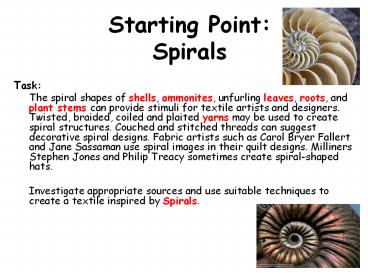Starting Point: Spirals - PowerPoint PPT Presentation
1 / 23
Title:
Starting Point: Spirals
Description:
Starting Point: Spirals Task: The spiral shapes of shells, ammonites, unfurling leaves, roots, and plant stems can provide stimuli for textile artists and designers. – PowerPoint PPT presentation
Number of Views:112
Avg rating:3.0/5.0
Title: Starting Point: Spirals
1
Starting Point Spirals
- Task
- The spiral shapes of shells, ammonites,
unfurling leaves, roots, and plant stems can
provide stimuli for textile artists and
designers. Twisted, braided, coiled and plaited
yarns may be used to create spiral structures.
Couched and stitched threads can suggest
decorative spiral designs. Fabric artists such as
Carol Bryer Fallert and Jane Sassaman use spiral
images in their quilt designs. Milliners Stephen
Jones and Philip Treacy sometimes create
spiral-shaped hats. - Investigate appropriate sources and use suitable
techniques to create a textile inspired by
Spirals.
2
(No Transcript)
3
Task 1 Mind-map
Make a mind-map of different spirals.
?
-clam shell -shiny -hard
Spirals
Shells
?
?
- Lesson Objective
- To understand the theme.
- To learn how to use mind-mapping to develop
initial ideas. - (SMSC creativity).
- To get a grade C or above you must
- Do a detailed mind-map.
- Explain in full sentences and show independent
thinking
?
4
DNA is the genetic building blocks for all life
forms
5
Viruses microscopic life-forms that cause
disease.
6
Finger prints these are unique to each person.
7
Shells protection for sea and land animals.
8
(No Transcript)
9
Coral home to tiny sea-creatures.
10
Ammonite prehistoric fossil
11
Animals and Insects
12
Plants twisting plant stems and leaves
13
Plants petals, flowers and seed formations.
14
Water whirlpools
15
Space Weather galaxies, weather systems and
cloud formations.
16
Architecture buildings, stairs, decorative
details.
17
Labyrinth mazes.
18
Manmade coils, wire and springs
19
What other spirals can you think of?
Add them to your mind-map
20
Task 2 Research spirals (AO1/AO3)
- Choose which spirals to research.
- Research your chosen spirals (key facts and
images). - Use the question sheets to help you.
21
Spirals Homework 1 (AO1/AO3)Research key facts
about the type of spirals you have chosen.Find
pictures to illustrate your research.Answer
these questions to help you to annotate your
research.
1. What type of spiral is it?
3. Where do you find this type of spiral?
2. Is it a man-made or natural spiral?
9. How could you develop it into a design?
4. What is it made of?
8. What textile techniques could you use to
represent it?
5. What key facts can you find out about it?
7. What materials could you use to represent it?
6. What shapes, patterns and colours stand out?
22
Task 3 Present your research
- Present your research in an imaginative way.
- You must include
- - a textured background
- - a title Spirals.
- - pictures and/or sketches.
- - annotation (correct spelling/punctuation).
23
Homework 1 Research drawing (AO2/AO3)
- Draw two spirals for your research.
- Shade in your drawing.































